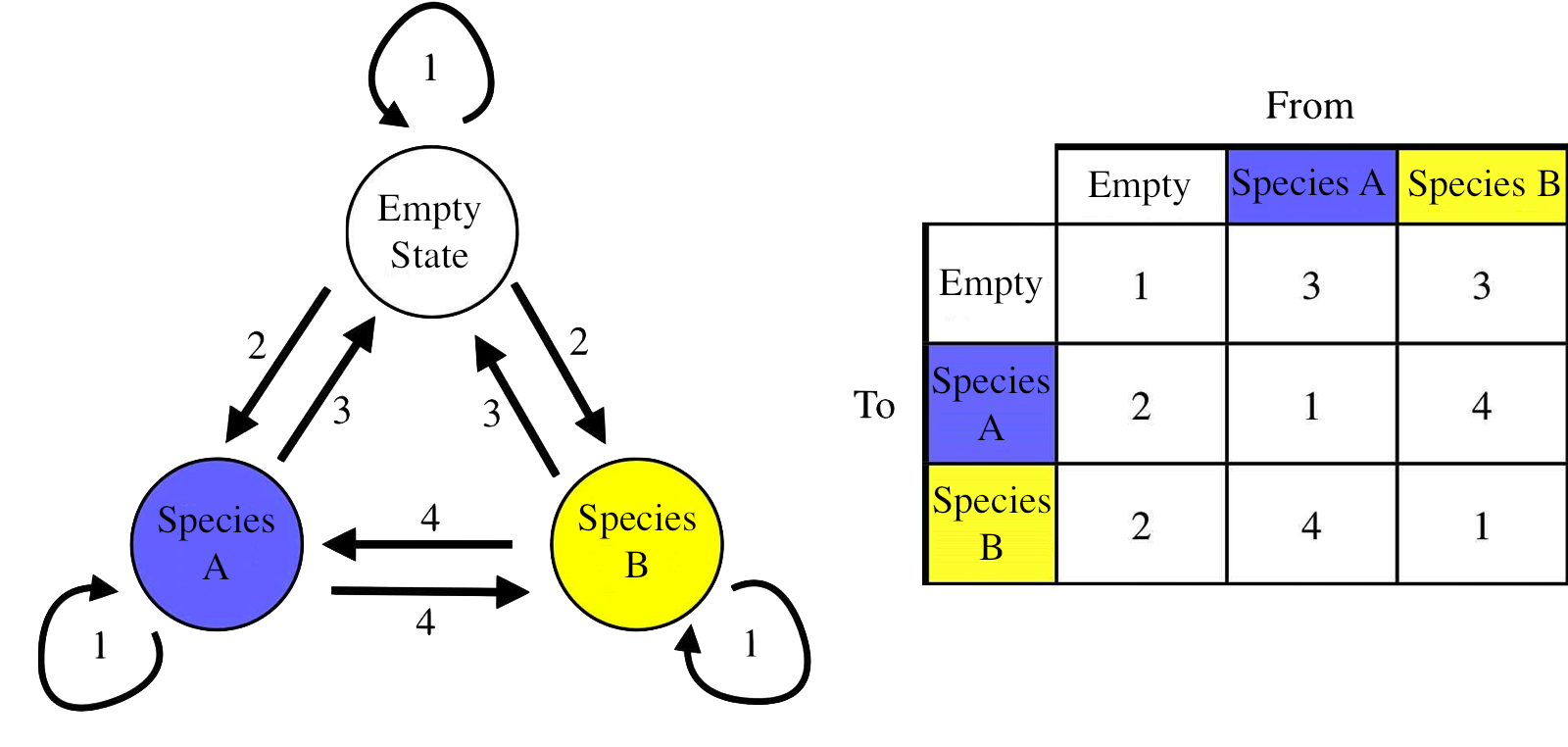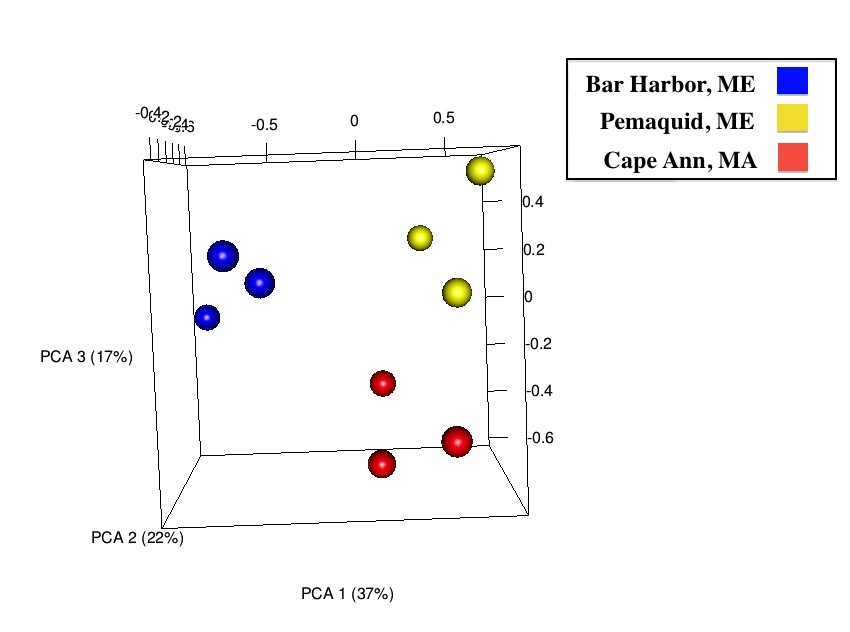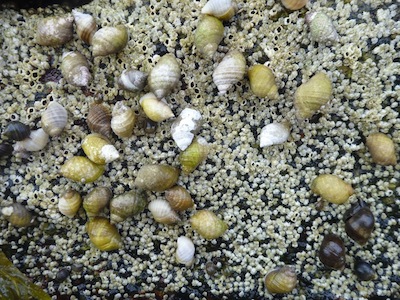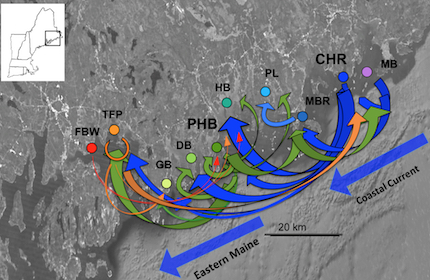
Intertidal Ecology in the Gulf of Maine
Regional Differences in the Forces Structuring Communities
In rocky intertidal environments, small scale biological interactions
(e.g. predation, herbivory, facilitation and competition) interact with large-scale gradients
(temperature, productivity, and recruitment) to produce shifting
patterns in community structure. While manipulative experimentation
has shown small
scale interactions to be paramount in controlling the structure and
function of coastal communities, recent work has underscored the
importance of large
scale gradients in modulating those interactions over both space
and time. We are interested in understanding how larger-scale processes shift local interactions which is critical for forecasting the effects of climate change and managing ecosystems.
Our approach involves quantifying transition probabilities (changes in space occupancy) between ecological states (e.g. mussel replaced by barnacle). Transition probabilities are used in many fields to model system
behavior. A Markov Chain Model (MCM) can then be used to predict the path a system will follow (figure 1).
These have been used effectively in marine habitats to predict
local dynamics
in coral
reef, subtidal, and intertidal communities. Although not mechanistic,
MCMs identify the relative importance of various species interactions in
community structure
and dynamics.
Scott Morello is quantifying transition probabilities of faunal
elements for local intertidal communities at three replicate
sites in southern,
mid-coast, and northern Gulf of Maine (Cape Ann, MA; Pemaquid,
ME; Bar Harbor, ME) (figure 2). Community dynamics and structure
can
be simulated
from local transition probabilities using MCMs and compared to
observed communities to test how MCMs capture the critical ecological
processes
influencing intertidal assemblages. The transition probabilities
themselves can also be compared regionally to aid in our understanding
of how
species interactions
shift in response to large-scale gradients (figure 3).
The Role of an Ecologically Important Predator
It has long been known that predators
are major structuring forces in communities, but the
specific pathways through
which this occurs can be complicated. In the 1970s, experiments
identified the carnivorous whelk Nucella lapillus as one
of the primary species
controlling community structure in the Gulf of Maine
intertidal. Using the aforementioned
MCM framework, our research also quantifies transition probabilities
in areas where Nucella lapillus has been excluded to help understand
the specific pathways through which this species effects community structure
, and how well
MCMs predict observed changes.
Population Connectivity among Mussel Populations
Understanding how populations are connected through dispersal is of fundamental importance in ecology, evolution, conservation and management, and will play a pivotal role in predicting how organisms might respond to contemporary anthropogenic stresses. Because of its obvious importance, a number of research programs have estimated patterns of connectivity from a variety of complementary approaches including larval ecology, hydrographic models, coupled bio-physical models and empirical estimates based on genetics and geochemistry. Recent reviews of these pioneering efforts have continually stressed the need to integrate biophysical models with larval ecology and empirical verification in an iterative process to improve model predictions and to better quantify spatial and temporal connectivity. Our research takes this next crucial step by building a biophysical model parameterized by empirical estimates of larval ecology and spatiotemporal differences in fecundity, and validated against independent measures of connectivity based on elemental fingerprints of larval shells. Our work explicitly integrates across-shelf and along shore processes into a coupled biophysical model of larval transport that should more completely capture the forces that influence the dispersal and connectivity of nearshore organisms.
Specifically, we are exploring the role of across-shelf mixing in the connectivity of blue mussel populations in eastern Maine. Hydrographic, current profile, and larval vertical migration data are being used to develop and validate a high-resolution coastal circulation model coupled to an individual-based model (IBM) of larval behavior. Connectivity predicted from this model is being tested against independent empirical estimates of connectivity based on elemental fingerprinting (Fig. 5). In addition to addressing fundamental questions relevant to ecology, evolution and conservation, our work will provide a detailed understanding of dispersal, connectivity and oceanography in the northern Gulf of Maine and have considerable practical utility for resource managers and fisheries biologist.
The following links provide details for some of this work:
http://rpubs.com/Scotty12g/IMM_LeaveOneOut_Larvae
http://rpubs.com/Scotty12g/IMM_LeaveOneOut_Juvenile
http://rpubs.com/Scotty12g/prelim-mussel-qda
http://rpubs.com/Scotty12g/Comparing_Larval_Geochem_Analyses
http://rpubs.com/Scotty12g/IMM_SimData_Analysis_2Extra

Figure 1: Transition types in a Markov Chain matrix: Self-self (1) (persistence), Empty to Filled state (2) (recruitment/growth), Filled to Empty state (3) (mortality), Filled to filled state (4) (species interactions).

Figure 2: Replicate locations across the Gulf of Maine

Figure 3: PCA of local transition probabilites shows separation of locations along the first three principle componenets

Figure 4: The Atlantic Dogwhelk, Nucella lapillus, primarily feeds on mussels and barnacles

Figure 5: A summary of preliminary estimates of larval dispersal and population connectivity of mussels in eastern Maine during our 2015 field season. Connectivity estimates were based on elemental fingerprints derived from eleven elements and assignments were based on a reference DFA of in situ larval fingerprints.